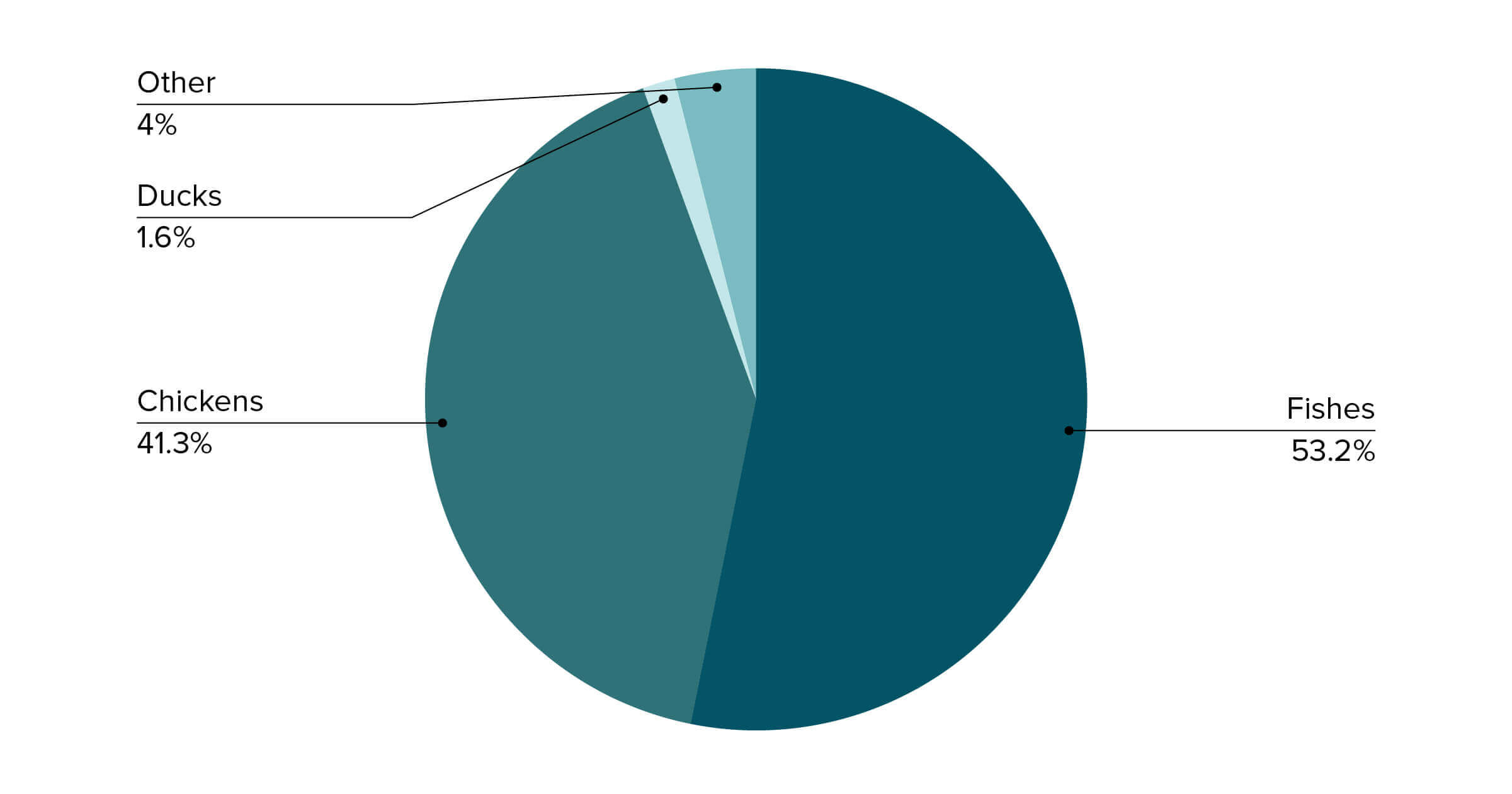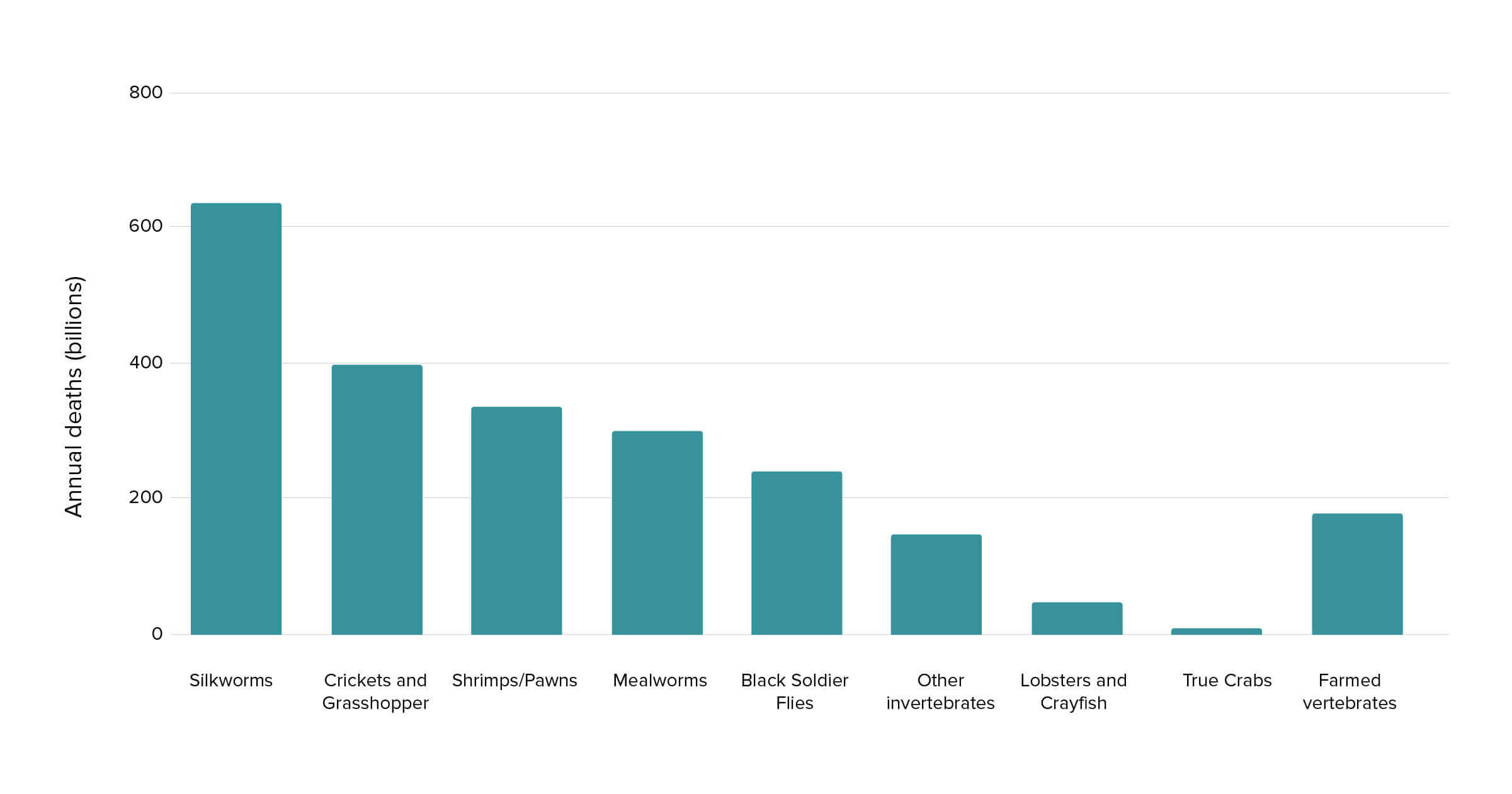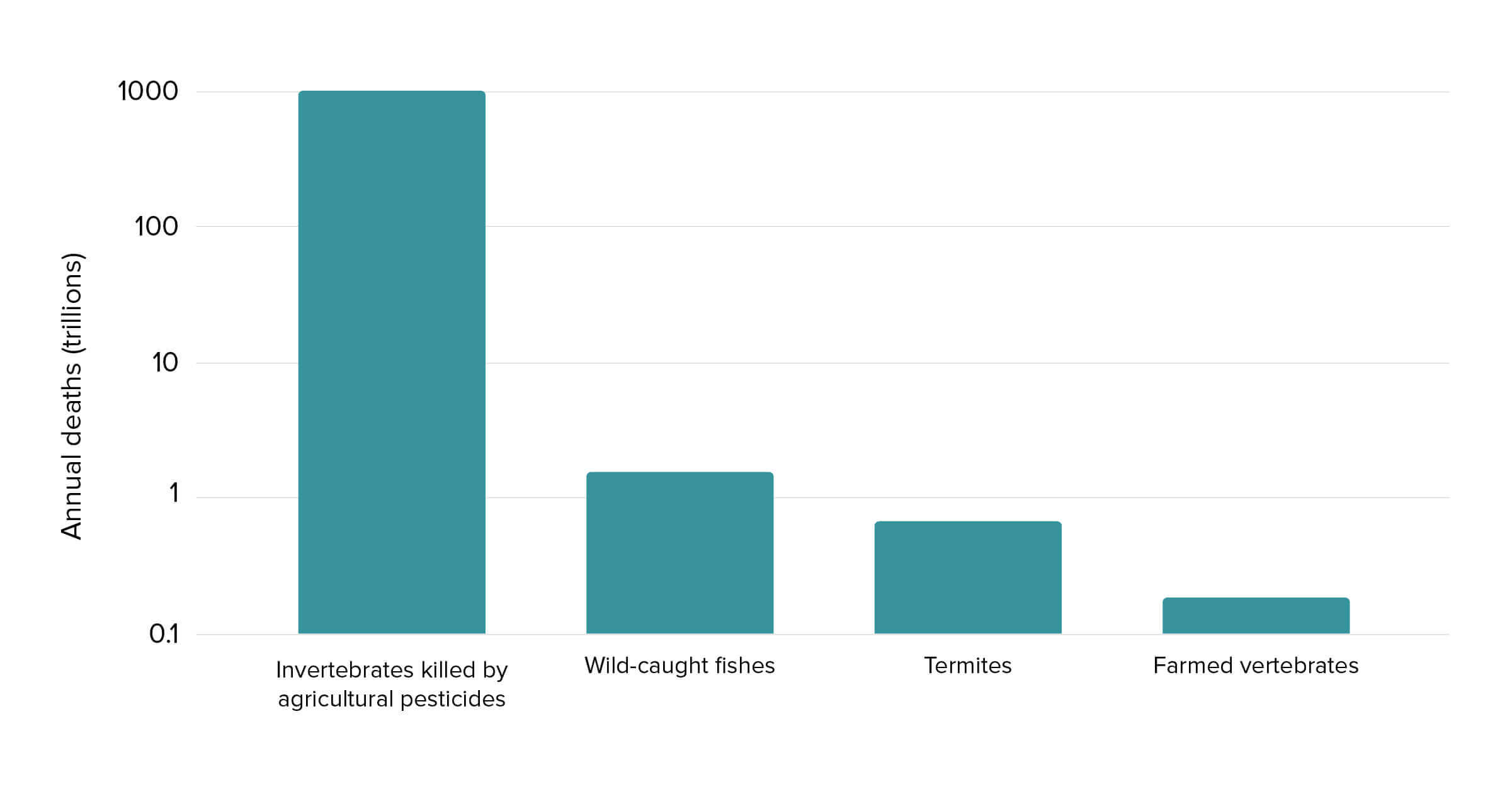The Most Numerous Animal Groups and Species – 2022
Summary
Animals suffer in various ways, and different problems call for different solutions. To prioritize what problems to focus on, we find it helpful to consider the scale of each problem. Here we discuss one important aspect of scale: the number of individuals in various animal groups and species. We do not believe that the number of individuals is the only relevant characteristic of scale, nor do we believe that animal groups or species should be prioritized solely based on scale. However, the number of individuals in a group or species is one characteristic of scale that we use for prioritization.
We compared the numbers of vertebrates raised by humans and found that animals killed for food represent the largest group, with 191 billion individuals killed per year. Among these individuals, farmed fishes and chickens are the most numerous (101 billion and 79 billion killed per year, respectively), making these promising groups to prioritize.

Fig. 1: Vertebrate animals killed for food by humans each year
We compared farmed invertebrates and found that their numbers greatly exceed those of farmed fishes and chickens, indicating that they should also be prioritized. Several groups of farmed invertebrates exceed the total number of farmed vertebrates. These groups include honey bee workers (26.4 trillion1), cochineals (9.93 trillion), and silkworms (636 billion), among others.
We also compared some groups of wild vertebrates and invertebrates that are killed by humans each year and found that their estimated numbers are even higher. These groups include termites (692 billion), wild-caught fishes (1.56 trillion), and invertebrates killed by pesticides (one quadrillion). There are many more animals in the wild (estimated to be as many as 1022, or 10 sextillion, of whom at least 10 trillion are vertebrates2) that likely experience varying degrees of suffering. This area of work is very neglected, and while it may be less tractable, we believe it is a promising avenue for further research.
When prioritizing causes, we considered arguments for prioritizing farmed versus wild fishes, as well as the distribution of farmed vertebrates (especially fishes and broiler chickens) throughout the world. We also considered how resources are distributed. Considering the number of animals within different groups can be helpful for prioritizing where resources should be directed, but it is not the only relevant factor for prioritization. Other important factors include the degree to which different species are sentient and the amount of suffering they endure in their lives. This means that we don’t necessarily believe that resources in the animal advocacy movement should be distributed according to how numerous each group is.
A Note on Metrics
In this article, we use the number of individuals as a proxy for the scale of animal suffering.3 However, we do not consider the number of individuals to be the only relevant metric. Other metrics that are relevant when comparing different animal groups include the severity and duration of suffering, which are affected by the conditions an animal is in, and the level or likelihood that members of a group are sentient.
The metric of sentience is especially relevant when comparing species—particularly invertebrate species, for whom there is less research on sentience available. We currently believe that the evidence for sentience of any invertebrate species is inconclusive and that more research is needed to make a confident assessment. However, we believe that there are enough signs of potential sentience4 for many species to err on the side of caution. The argument for a cautious approach is strengthened by the massive numbers of invertebrates. See the Invertebrates section for more details.
To limit the scope of this article, we continue to compare only the numbers of individuals in different animal groups and not their lifespans, severity of suffering, or level of sentience. We believe, in most cases, that the number of individuals is a useful initial proxy for the scale of an issue.
Farmed Animals
Humans breed animals for multiple purposes including companionship, vivisection, fur, and food. Of animals bred by humans, the magnitude of animals farmed for food is by far the largest. In 2016, we estimated that the number of land vertebrates farmed for food in the U.S. is thousands of times higher than the number of dogs and cats euthanized in shelters—see our Why Farmed Animals page for more information on farmed animals.
Fishes and Chickens
The chart below shows the most numerous groups of farmed vertebrates killed for food around the world. Our estimate of land animals is based on data for slaughtered animals from the Food and Agriculture Organization of the United Nations (FAO) website FAOSTAT.5 This dataset covers total meat production from both commercial and farm slaughter, but it does not account for pre-slaughter mortality rates or include, for example, male chicks culled in the egg industry.6

Fig. 2: Farmed vertebrates killed for food by humans each year. Of farmed vertebrates killed annually for human consumption, farmed fishes make up the majority (101 billion), followed by chickens (79 billion) and ducks (3.0 billion).7 The remaining (7.6 billion) individuals consist of birds and mammals.
Farmed fishes8 and chickens, especially chickens farmed for their meat as opposed to their eggs,9 currently make up the vast majority of vertebrate animals farmed for direct human consumption. An estimated 101 billion farmed fishes and 79 billion chickens were killed for human consumption in 2017 and 2020, respectively, accounting for about 95% of all vertebrate animals farmed for this purpose. While farmed fishes make up the majority of farmed vertebrates killed for direct human consumption, the proportion differs per region.
Within the context of farmed vertebrates, efforts that target farmed fishes and chickens may be particularly promising given the large number of animals in these groups. While we are less certain about the tractability of implementing farmed fish welfare improvements, there have been some recent successes with corporate campaigns.10 We think that more research into promising interventions and species of fishes to prioritize is likely needed to improve the tractability of fishes’ welfare interventions.11
Invertebrates
Invertebrates make up a diverse group of animals, but limited research has been done into the sentience of invertebrate species. The available research has been synthesized by various animal advocacy research groups.12 Based on these reviews, we believe that evidence for the sentience of any invertebrate species is inconclusive and that more research is needed to make a confident assessment. However, we believe that there are enough signs of potential sentience13 for many groups or species to err on the side of caution. The argument for a cautious approach is strengthened by the massive numbers of invertebrates that we will discuss in this section. Even if there is only a small likelihood that invertebrates are sentient and we discount the value of working on their welfare accordingly, the scale of their interests may still be large in comparison to the scale of other animal groups.
Information on the number of farmed invertebrates is highly uncertain. For many groups of invertebrates, there are no estimates. However, estimates made in the report “The Scale of Direct Human Impact on Invertebrates” by Abraham Rowe (2020) indicate that many subgroups of farmed invertebrates are more numerous than the total number of farmed vertebrates. The largest group of farmed invertebrates are cochineals, an insect farmed to produce a type of red dye. Rowe estimates that 9.93 trillion cochineals are killed each year during the farming process.14 Rowe also estimates that 26.4 trillion honey bee workers are used each year.15 We say “used” and not “killed” because it is unclear how many honey bees are killed by humans and how many die a natural death.

Fig. 3: Farmed invertebrates used or killed annually compared to total farmed vertebrates killed annually. Comparing Rowe’s estimated numbers of honey bee workers, farmed cochineals, and other farmed invertebrates to the total number of farmed vertebrates, we see that honey bee workers and farmed cochineals greatly exceed all other groups.
Omitting honey bee workers and cochineals, we find that many of the relatively smaller subgroups of farmed invertebrates are also more numerous than the total number of farmed vertebrates. These subgroups include silkworms16 and various subgroups of insects and crustaceans used for direct human and nonhuman consumption.

Fig. 4: Farmed invertebrates (cochineals and honey bees excluded) killed annually compared to farmed vertebrates killed annually. Based on Rowe’s estimates, many subgroups of farmed invertebrates are more numerous than the total number of farmed vertebrates.
As ACE evaluates and supports approaches within the animal advocacy movement, most of our work concerns vertebrate animals. However, when we consider the arguments of scale and neglectedness, the numbers of animals suggest that invertebrates should receive more attention from the farmed animal advocacy movement than they currently receive. Even though they make up the most numerous group of farmed animals, few farmed animal organizations address issues that invertebrates face17.
Wild Animals Killed by Humans
Wild animals are killed by humans in even larger numbers than farmed animals. We believe this cause area may be less tractable because it is relatively easier to improve animal welfare in human-controlled farms than it is in natural environments, where humans have less control over the conditions that affect animal welfare. Here we include some groups of wild animals that are directly impacted by humans: wild-caught fishes, invertebrates killed by agricultural pesticides, and termites killed by pest control.18 We acknowledge there are many groups of wild animals killed by humans that may be more numerous than the groups discussed here.

Fig. 5: Certain wild animals killed annually compared to farmed vertebrates killed annually. When we consider three of the many groups of wild animals affected by humans (invertebrates killed by agricultural pesticides, wild-caught fishes, and termites), we see these three groups are more numerous than farmed vertebrates.
We recognize that the numbers for invertebrates killed by pesticides are less rigorous, but showing a best estimate,19 invertebrates killed by agricultural pesticides greatly exceed all other groups of farmed and wild animals killed by humans. We recognize that the groups we considered are not exhaustive and that we are likely missing key groups of animals.
Wild Animals Killed and Harmed by Natural Causes
Lastly, we believe that concern for animals shouldn’t be restricted to those whose suffering is directly caused by humans. We believe that in the ideal case, wild animals who suffer from natural causes, such as hunger, disease, or natural disasters, should be helped. The case for addressing wild animal suffering caused by humans or nonhumans has been made by prominent economists, philosophers, and effective altruists20 and ACE has hosted blog posts21, conducted research22, and funded research on the topic.
It has been estimated that the total number of wild vertebrates is at least 10 trillion, and that the total number of wild animals including invertebrates is as many as 1022, or 10 sextillion,23 making wild animals the most numerous group discussed in this article. We do not necessarily believe that this means that all resources in animal advocacy should go toward this group. Wild animal welfare may be harder to assess and influence, and addressing wild animal suffering that is not directly caused by humans is likely to be less tractable than addressing the welfare of farmed animals or wild animals impacted by humans. However, as this is such a numerous group, promoting concern for wild animals now seems critical.
Read more about our thoughts on reducing wild animal suffering on our Cause Area Priorities for Animal Advocacy page.
References
Animal Charity Evaluators. (2016, November). Why farmed animals? https://animalcharityevaluators.org/donation-advice/why-farmed-animals/
Animal Charity Evaluators. (2020, April). Farmed fish welfare report. https://animalcharityevaluators.org/research/other-topics/farmed-fish-welfare-report/#reforms-improve-welfare
Animal Ethics. (n.d). Animal sentience. Retrieved January 25, 2022 from https://www.animal-ethics.org/sentience-section/animal-sentience/
Billington, T., & King-Nobles, H. (2020, February). An overview of approaches for fish welfare improvements. Fish Welfare Initiative. https://6f025a9b-7462-434d-abfa-6f1d652e15fe.usrfiles.com/ugd/6f025a_dacb45c052514dbbb30ecbff7cd600e7.pdf?fbclid=IwAR0mJHzNnkR6f0OtnAlKDCGOqxuzkUjcpNR5J0RtxMU2lm8edBVNB5obRn0
Eskander, P. (2018, February 13). To reduce wild animal suffering we need to find out if the cause area is tractable. Animal Charity Evaluators. https://animalcharityevaluators.org/blog/to-reduce-wild-animal-suffering-we-need-to-find-out-if-the-cause-area-is-tractable/
Food and Agriculture Organization of the United Nations (FAO). (2018). The state of world fisheries and aquaculture: Meeting the sustainable development goals. https://www.fao.org/3/i9540en/i9540en.pdf
Hecht, L. (2016, September 5). Wild animal suffering survey report. Animal Charity Evaluators. https://animalcharityevaluators.org/blog/wild-animal-suffering-survey-report/
Horta, O. (2015, January 5). Why the situation of animals in the wild should concern us. Animal Charity Evaluators. https://animalcharityevaluators.org/blog/why-the-situation-of-animals-in-the-wild-should-concern-us/
Humane Slaughter Association. (2018, August 4). HSAFinfishConsumerVideo23August2018 [Video]. https://www.youtube.com/watch?v=sjXfvJbl8MY&t=241s
Invertebrate Welfare. (2020a, July). Invertebrate Welfare — July 2020. https://www.invertebratewelfare.org/newsletter/2020-07
Invertebrate Welfare. (2020b, August). Invertebrate Welfare — August 2020. https://www.invertebratewelfare.org/newsletter/2020-08
McMahan, J. (2010, September 19). The Meat Eaters. The New York Times. https://opinionator.blogs.nytimes.com/2010/09/19/the-meat-eaters/
Ng, Y. K. (1995). Towards welfare biology: Evolutionary economics of animal consciousness and suffering. Biology & Philosophy, 10, 255–285. https://doi.org/10.1007/BF00852469
Open Philanthropy Project. (n.d.). Farm animal statistics. https://docs.google.com/spreadsheets/d/1uF3x_DuG13V6NpkP4DQyFutZI6Pwppy5R6qGArPZ1h0/edit#gid=265676572
Rowe, A. (2020, September 2). The scale of direct human impact on invertebrates. Rethink Priorities. https://rethinkpriorities.org/publications/the-scale-of-direct-human-impact-on-invertebrates
Rowe, A. (2021a, February 20). Global invertebrates harmed and farmed [Model] . Guesstimate. https://www.getguesstimate.com/models/16744
Rowe, A. (2021b, April 6). Global cochineals killed for dye [Model] . Guesstimate. https://www.getguesstimate.com/models/14905
Rowe, A. (2021c, April 19). Silk production: Global scale and animal welfare issues. Rethink Priorities. https://rethinkpriorities.org/publications/silk-production
Salazar, M. (2019, July 31). Why is welfare biology important? Animal Charity Evaluators. https://animalcharityevaluators.org/blog/why-is-welfare-biology-important/
Sarek, K., Savoie, J., & Moss, D. (2019). Improving environmental conditions – A summary. Charity Entrepreneurship. https://drive.google.com/file/d/1vHhpzJje2UKOu2CvvaufbLyiu8WmuJfq/view
Šimčikas, S. (2019, December 5). Accuracy issues in FAO animal numbers. Rethink Priorities. https://rethinkpriorities.org/publications/accuracy-issues-in-fao-animal-numbers
Šimčikas, S. (2020, February 18). Estimates of global captive vertebrate numbers. Rethink Priorities. https://rethinkpriorities.org/publications/estimates-of-global-captive-vertebrate-numbers
Tomasik, B. (2019, August 7.) How many wild animals are there? Essays on Reducing Suffering. https://reducing-suffering.org/how-many-wild-animals-are-there/
Tomasik, B. (2020, May 24). The Importance of Wild-Animal Suffering. Center on Long-Term Risk. https://longtermrisk.org/the-importance-of-wild-animal-suffering/
WP Finanse. (2019, September 26). Tesco rezygnuje ze sprzedaży żywych karpi. Klienci kupią tylko mrożone ryby. [Tesco abandons the sale of live carps. Customers will only buy frozen fish.]. https://finanse.wp.pl/tesco-rezygnuje-ze-sprzedazy-zywych-karpi-klienci-kupia-tylko-mrozone-ryby-6428709232146561a
Royal Society for the Prevention of Cruelty to Animals (RSPCA). (2018). RSPCA welfare standards for farmed rainbow trout. https://science.rspca.org.uk/documents/1494935/9042554/RSPCA+welfare+standards+for+farmed+Rainbow+trout+%28PDF+2.29MB%29.pdf/36aeab04-e2f1-8875-d8ae-f7c4ff724c4d?version=1.0&t=1557668422472&download=true
Waldhorn, D., Schukraft, J., Carpendale, M., Hurford, P., & Davis, M. A. (2020, February 5). Invertebrate Sentience Table. Rethink Priorities. https://rethinkpriorities.org/invertebrate-sentience-table
Wild Animal Initiative. (n.d.). Research. Retrieved January 25, 2022 from https://www.wildanimalinitiative.org/research
In this article, we mostly rely on the number of deaths to estimate the total number of individuals. For some honey bee workers, we only estimate the number of individuals used, as it is unclear how many bees are killed by humans versus how many die a natural death after having been used by humans. We acknowledge that this difference makes for a less accurate comparison.
In many cases, considering the numbers of animals means considering the numbers of animal deaths, as these numbers are most readily available.
This data is largely collected by member countries. To read more about potential accuracy issues in FAO data on animals, see Šimčikas (2019).
Rough estimates for male chicks killed by the egg industry are between three and eight billion per year, according to Šimčikas (2020).
These reported numbers are our best estimate. The data are from 2020 with the exception of the numbers of farmed fishes and quails, which are from 2017. The number of animals slaughtered each year fluctuates and we are comparing between years, so we expect the real percentages to be different.
We use the plural “fishes” here to reflect that humans farm several hundred different species of fishes. FAO (2018) notes that “[a]s of 2016, global production has been recorded for a total of 598 ‘species items’ ever farmed in the world. A species item refers to a single species, a group of species (where identification to the species level is not possible) or an interspecific hybrid. Species items recorded so far include 369 finfishes (including 5 hybrids), 109 molluscs, 64 crustaceans, 7 amphibians and reptiles (excluding alligators, caimans or crocodiles), 9 aquatic invertebrates and 40 aquatic algae.” Unless otherwise specified, throughout this analysis, the term “fishes” refers to aquatic vertebrates and excludes aquatic invertebrates and aquatic mammals, reptiles, amphibians, and plants.
There are different estimates of the average number of chickens farmed for their meat (i.e., broiler chickens) and the average number of chickens farmed for their eggs (i.e, egg-laying chickens) alive at any time. Open Philanthropy Project estimated that approximately 54% of farmed chickens alive in 2017 were broiler chickens, while Šimčikas (2019) estimated that approximately more than 60% of farmed chickens alive in 2018 were broiler chickens. Both estimates indicate that there are more broiler chickens alive at any time than there are egg-laying chickens alive at any time. Given that broiler chickens are typically slaughtered at a much younger age than egg-laying chickens, we expect that an even greater number of broiler chickens are killed annually than egg-laying chickens.
RSPCA (2018); Humane Slaughter Association (2018); WP Finance (2019)
For existing research into approaches and reforms to improve the welfare of farmed fishes, see Billington & King-Nobles (2020) and our Farmed Fish Welfare Report. Some interventions to improve the welfare conditions of farmed fishes, such as managing dissolved oxygen levels, may be relatively inexpensive to implement; see Sarek et al. (2019).
Waldhorn et al. (2020); Wild Animal Initiative (n.d.); Animal Ethics (n.d.)
We arrived at this number by considering the median of the cell TDD, “Total additional deaths added by farming”, in Rowe’s Global Cochineals Killed for Dye model.
We arrived at this number by considering the median of the cell HWO1, “Honeybees (workers only)”, in Rowe’s Global Invertebrates Harmed and Farmed model.
For some organizations that work on invertebrate issues, see Invertebrate Welfare (2020b) Not all of the groups listed work on farmed invertebrates.
We arrived at this estimate by taking the median value of Rowe’s range of 100 trillion to 10 quadrillion annual deaths, assuming a lognormal distribution.